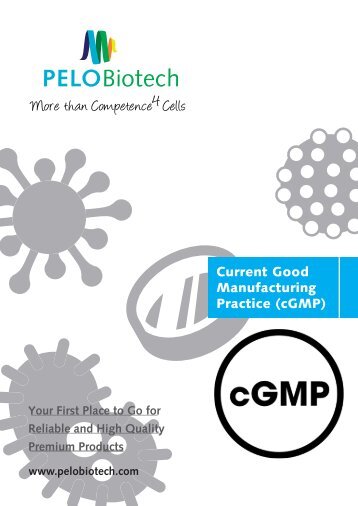PELONews April/May 2019
- Text
- Hydrogel
- Fluorescent
- Pelonews
- Hydrocell
- Pelobiotech
- Primary
PELONews New Products Ultralow Cell Binding Cultureware HydroCell is a low cell biding cultureware. On its surface, super hydrophilic polymer was immobilized at nano-thickness. This hydrophilic character helps the formation of embryoid bodies of ES/iPS cell or Spheroid in culture.: Compared to other brands' low cell binding cultureware, HydroCell shows lower cell binding. • Super hydrophilic polymer is immobilized to the surface of the cultureware at nano-thickness. • Lowest attachment rate among similar competitive brands. • Three formats : Microplates, Dishes and Flask types. Fig.1 Overview of HydroCell surface • Formation of embryoid bodies of ES cells in culture • Formation of anchorage-independent colonies • Differentiation such as cartilage (spheroid formation) • Culture & storage of macrophage/immune cells • Screening of anti-cancer drugs (replacement for soft agar assays) Fig.2 Comparison to other brand products Mouse macrophages were incubated for 3 days in (1) HydroCell, (2) another brand's product and (3) non-treated cultureware. Only HydroCell allowed uniform suspension culture (>99% of the cells remained in suspension), simple cell dissociation and harvesting by pipetting. For 3D Cell Culture Fig. Stem cell sphere formation iPS spheres are formed on HydroCell (left) or other brand low cell binding dish.A complete sphere was surely formed on HydroCell, while adhesion was observed on other low cell binding dish. (Data provided by A. Umezawa, National Center for Child Health and Development) For more infos and prices, just call us: 0049 89 517286 59–0
Reversible Fluorescent Dye for Nucleus NucleoSeeing is a novel live cell imaging probe which emits green fluorescence by binding to DNA specifically. NucleoSeeing can be used for not only in animal cells or tissues, but also Guard cell of Arabidopsis thaliana with high S/N ratio. Moreover, NucleoSeeing can be used as a pH sensor in nucleus. This product has been commercialized under the license from Nagoya Institute of Technology. NucleoSeeing is composed of green fluorescent dye and DNA binding tag. Under DNA free condition, Nucleoseeing is in folded conformation and no fluorescent is emitted. However, once it binds to DNA, the conformation will change andemitts green fluorescence. Ex/ Em Fluoresce nce Phototoxicity Nucleu s Spe cifici ty Cell Me m. Permea bilit y Cyto- toxi- city Live Fixed NucleoS Green Low Yes Yes Low Yes Yes 488/ 520 eeing Hoech 350/ st 461 DAPI 350/ 461 Company X Company Y 485/ 498 646/ 680 Blue High Yes Yes Hig h Yes Yes Blue High Yes No N/A No Yes Green Low No Yes N/A Yes Yes Red Low Yes Yes Hig h Yes Yes Comparison table of dyes for nucleus Fig.1 Staining of nucleus in various cultured cells References 1. Nakamura, A., et al., Chem. Commun., 50, 6149-6152 (2014) Hoechst tagging: a modular strategy to design synthetic fluorescent probes for live-cell nucleus imaging. 2. 2. Ueda, M., et al., ACS Cent. Sci., 3 (5), 462-472 (2017) Noncanonical function of a small-molecular virulence factor coronatine against plant immunity: an in vivo raman imaging approach. 3 papers is equal to NucleoSeeing. 3. Nakamura, A. and Tsukiji, S., Bioorg. Med. Chem. Lett., 27 (14), 3127-3130 (2017)Ratiometric fluorescence imaging of nuclear pH in living cells using hoechst-tagged fluorescein. * hoeAc2FL in above More Product Information/Datasheet here.
- Page 1 and 2: PELONEWS WITH FOCUS ON PRIMARY CELL
- Page 3 and 4: Here some impressions of this great
- Page 5: Assays&Arrays WHITE PAPER | Off-Tar
Inappropriate
Loading...
Mail this publication
Loading...
Embed
Loading...
About us
This website is published by
PELOBIOTECH Gmbh
Am Klopferspitz 19
82152 Planegg/Martinsried
(Phone): +49 89 517 286 59-0
(Fax): +49 89 517 286 59-88
E-Mail: info@pelobiotech.com
Managing directors:
Dr. Lothar Steeb
Dr. Peter Frost
Registergericht/Trade register:
Amtsgericht München HRB 197203
UID-Nr: DE282095341
EORI-Nr.: DE513247033551940
Responsible for the content (V.i.s.d.M.):
Dr. Peter Frost
Linked Sites: Although we thoroughly check all sites linked to our webpage, we decline any responsibility for their contents.






































Follow Us
Instagram
Email
LinkedIn
Twitter